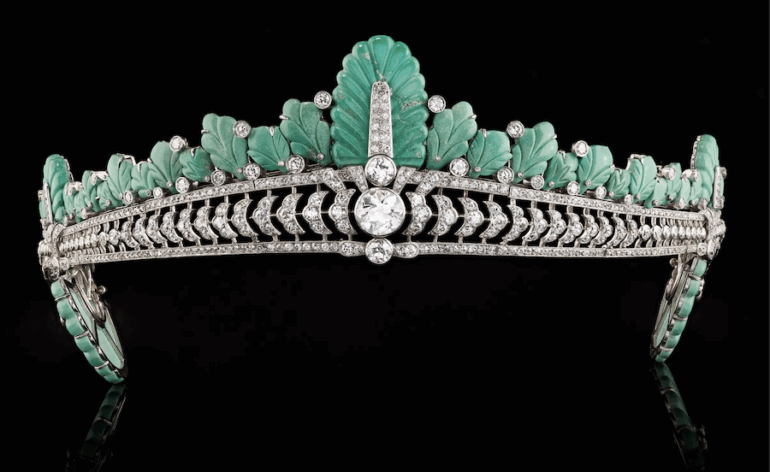December babies have as their birthstone a talisman imbued by ancient cultures with all the powers of sea and sky — potent forces whether or not you live off the land, as they did.
The word “turquoise” comes from the French pierre turquoise, meaning Turkish stone, and dates to the 13th century when Venetian merchants bought turquoise jewels in Turkish bazaars and resold to the European market.
But turquoise jewelry was a hot item long before then. The oldest comes from Mesopotamia (ancient Iraq), c. 5,000 B.C.
In the U.S., we tend to associate turquoise with Native American jewelry. The Navajo in particular are known for using locally-mined turquoise in their inlay, often paired with complementary red coral, carnelian or fire opal — a palette so integral now to Arizona and New Mexico, you can find it everywhere from regional fashion to interior design. It’s one of the pleasures of landing in the desert in mid-winter to be hit in the eyes with that vibrant combo.
Less known than Navajo jewelry but no less important is jewelry made by the Zuni people, using a similar palette and materials. The Zuni learned jewelry-making from their Navajo neighbors in the 19th century but tended to use smaller inset stones and finer silver inlay, influenced more, it seems, by Spanish and Mexican designs than the Navojos. You can find rare examples of Zuni turquoise jewelry at the Millicent Rogers Museum in Taos, New Mexico (including the necklace pictured above). I bought some beautiful Zuni silver inlay outside Zion National Park a few years ago.
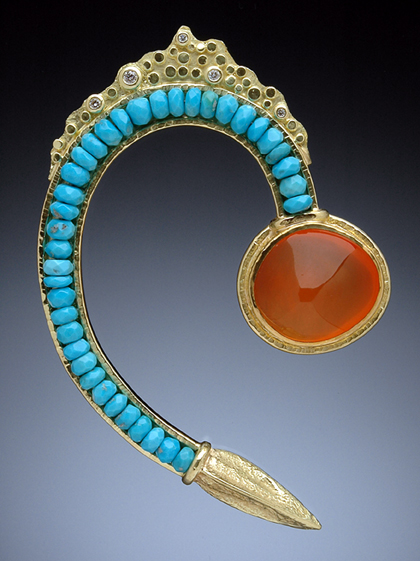
But turquoise is an ancient, global phenomenon. It was long believed to ward off every evil known to man. It shows up in the jewelry of ancient Asia, Tibet, Persia, Turkey and Eqypt. In ancient Rome, turquoise was believed to protect against falling horses — a common occurrence, I guess? Interesting, since the symbol for Sagittarius is the centaur.
In China and Tibet, turquoise was also worn to attract prosperity. While jade remained the ultimate talisman in China, Tibetans valued turquoise above all other gems.
Egyptians wore turquoise as far back as 4,000 B.C. It was among the gems found on the mummy of Tuthankhamen, which was decorated with 143 pieces of jewelry. King Tut ruled Egypt in the mid-1300s B.C. and those particular jewels were probably designed to avert evil in the afterlife and alert the gods to his power and importance.
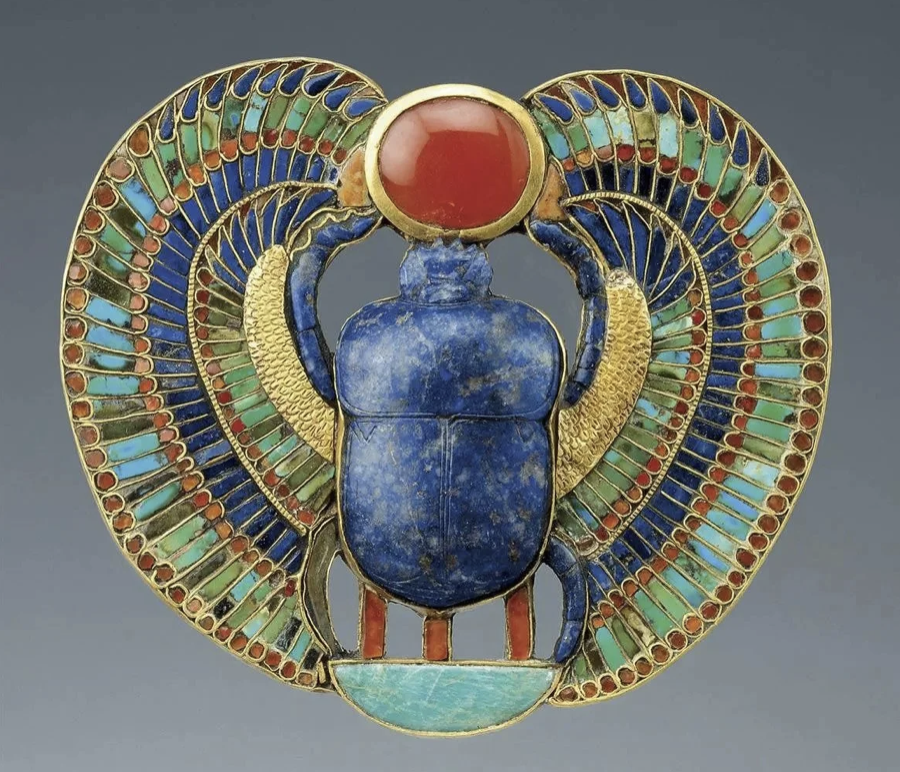
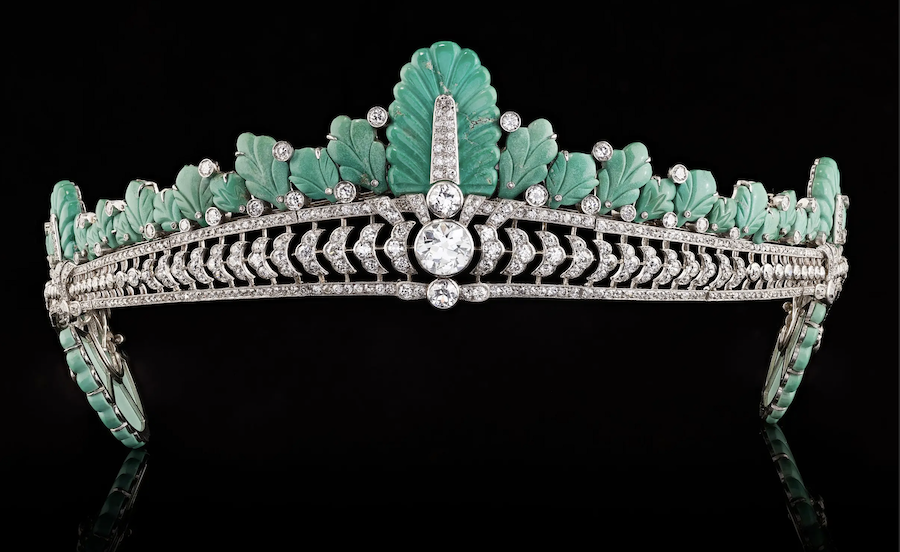
By the 20th century, turquoise was once again being incorporated into the highest levels of luxury, the finest of which are in high demand now. Take, for example, the Cartier tiara (above) made in 1930 and purchased by Lord Astor for Nancy Astor, the Viscountess Astor (1879-1964). She must have looked a bit like a blinged-out chieftess when she wore this.
The tiara stayed in the family for almost a century, passed from generation to generation, before ending up on the block last summer. It sold for a staggering $1,206,737 at Bonhams, London, in June 2025 — more than 3x its presale estimate.
How to shop for turquoise
It’s wise to inquire about treatments and request a guarantee of quality and origin. I learned this the hard way many years ago when I bought a pair of “turquoise” earrings with large stones of a deep, classic turquoise blue webbed with convincing black veins. The stones (or whatever they were) faded to almost white within a year. To be fair, I paid very little for them. These days, I’d look askance at any turquoise jewelry with a price that low.
There’s not much richly-colored natural turquoise around any more. Imitations abound, including dyed organic material like coconut husks.

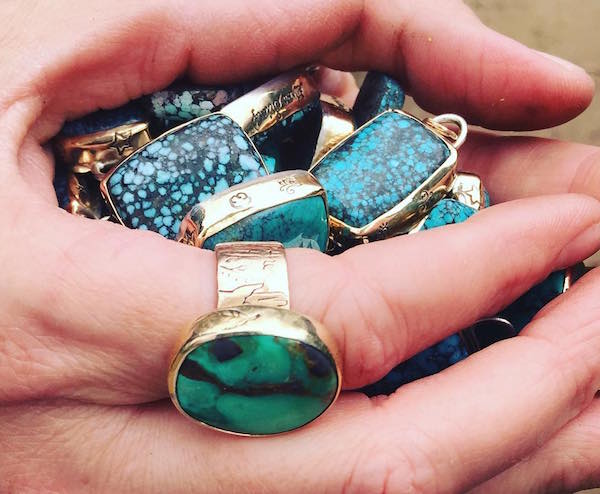
Untreated pure blue turquoise is particularly rare – especially the coveted sky-blue Persian variety – and that drives up prices and attracts knockoffs. Vivid blue stones from the famous Sleeping Beauty mine in Arizona are now so valuable they’re approached as precious gems, set with diamonds and gold like this ring by Larisa Laivins at Ylang 23.
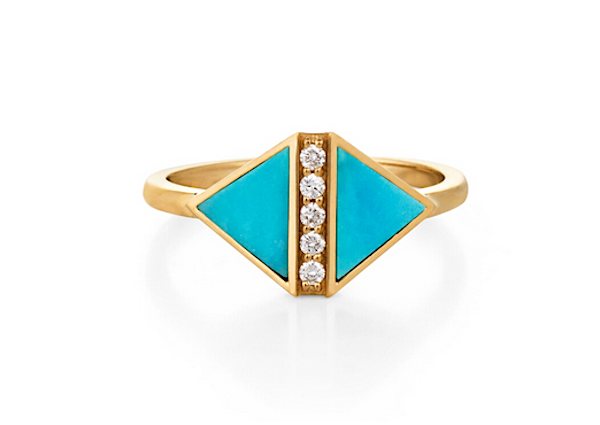
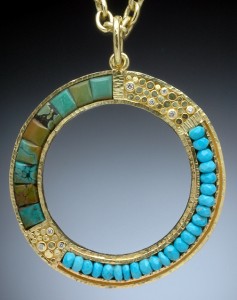
I actually love the less expensive mottled green Chinese turquoise webbed with black, and designers like Nancy Michel and Hughes-Bosca make luscious jewelry by contrasting it with gold, diamonds or purer blue varieties (pictured).
Treatments are common and sellers won’t always volunteer that information. If you ask though, a reputable dealer may admit their turquoise was stabilized, which is not necessarily bad if it improves the stone permanently and not just long enough to fool unsuspecting buyers.
The stones in the earrings I mentioned looked too substantial for the costume-jewelry price I was paying; that should have alerted me. But don’t be too paranoid. I’ve purchased several varieties since from various sources, and — unlike those cheap earrings I purchased long ago — all have held their color and finish. Ask for details about treatments. As with everything, they should be reflected in the price.
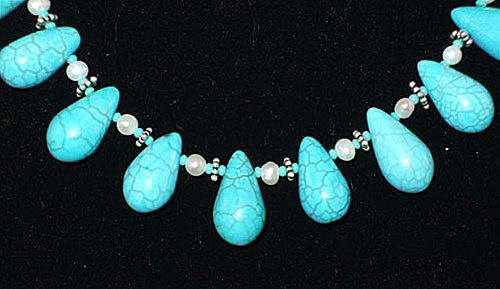
Common treatments for turquoise include colored-plastic impregnation, used to increase durability and turn whitish, porous stones blue. A similar process using wax instead of plastic can also change color and seal pores. Both can be detected with magnification, so use that loupe!
For more information
Designers featured here can be found at: Hughes-Bosca/Side Street Gallery, Mobilia, Jes MaHarry, and Ylang 23.
Background on the history and treatment of turquoise for this article came primarily from Gems & Crystals from the American Museum of Natural History and back issues of Lapidary Journal.
This book also comes highly recommended: Turquoise Mines, Minerals, and Wearable Art. If you’re looking for an up-to-date buying guide (2025), try Turquoise: Identifying and Collecting the Southwest’s Iconic Gemstone.

